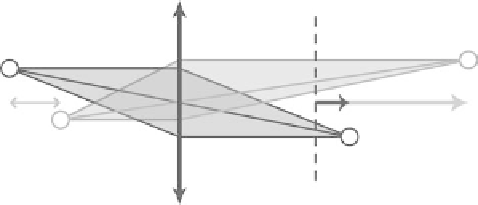Biomedical Engineering Reference
In-Depth Information
Objects
Images
d
d
+ Δ
d
Δ
z
Imaging
lens
Hologram
plane
FIgurE 9.13
Determination of axial position by numerical field propagation. The reconstruction distance
needed to bring the image in focus is directly related to the axial position of the object.
In bright-field digital holography, this method is not always easy to implement, mostly because it
requires focus-detection algorithms to cope with high background scattering. In holographic SHG
imaging, focus detection is made much simpler by the absence of background scattering, and as a simple
rule, the focus position corresponds to the highest SHG intensity.
The efficiency of this method depends on the precision at which can be determined the recon-
struction distance that brings the image in focus. While the reconstruction distance can be incre-
mented by infinitely small values, the changes in focus might not be detectable. The sensitivity thus
strongly depends on the longitudinal magnification of the imaging system, and is ultimately limited
by the SHG wavelength, the pixel pitch and possibly the hologram bit depth that together determine
the extent of the diffraction. Indeed, for very small reconstruction distance increments, numerical
field propagation (or diffraction) spreads the intensity of reconstructed wavefront only to immediate
neighbor pixels, thus limiting the sensitivity at which focus can be determined. For a 100× micro-
scope objective, a precision of about a few hundreds of nanometers was evaluated for determination
of axial position (Shaffer et al
.
, 2010a). This method is however expected to perform better in the
micrometer range.
The one major disadvantage of this method is its greedy use of resources that makes it quite time
consuming. The problem is that one hologram has to be numerically reconstructed many times to detect
the axial position of only one SHG scatterer. While this is not dramatic (it may take seconds or possibly
minutes to localize a distribution of SHG scatterers), it prevents the method from working in real time
at video frame rates.
Method 2: Determination of axial position from direct SHG phase value
: There is another and more
sensitive method to determine the axial position of an SHG scatterer that is also less time-consuming. It
is based on the direct relation that exists between the SHG phase reconstructed from the hologram and
the axial position of SHG.
We saw in Section 9.5.3 that the SHG phase in a given plane depends on the phase of the
fundamental-wavelength illumination at the position of SHG, as well as on the optical path length (at
SHG wavelength) from there to the plane of interest (Figure 9.14a). It follows that, in the plane of inter-
est, the phase of second harmonic generated by different individual nanoparticles under plane-wave
illumination directly depends on their respective axial position (Figure 9.14b).
For SHG scatterers dispersed in a nondispersive uniform medium, the SHG phase relates to the rela-
tive axial position by Equation 9.21
=
2
π
λ
∆ ∆
ϕ
(
z
)
n z
∆
,
(9.21)
0
which states that a change in axial position corresponding to the fundamental wavelength in the said
medium λ/
n
sees the SHG phase vary by 2π. This makes the method very sensitive to small changes

